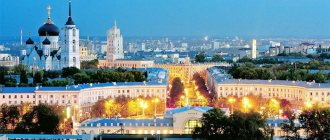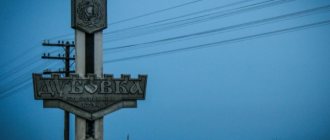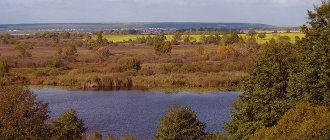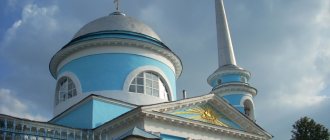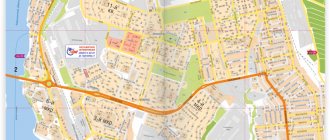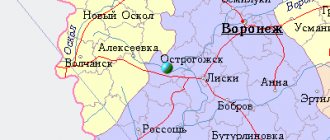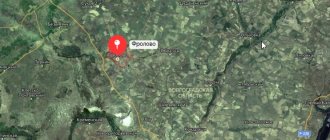On the left bank of the Vorona River, near its confluence with Khoper, on the edge of the dense Tellerman Forest, lies the greenest city in the Voronezh region - Borisoglebsk. He owes his title to the activities of the scientist and forester I. Zakusin, who in the 1950s developed a plan for landscaping Borisoglebsk and over the next decade successfully implemented it.
The city traces its history back to May 15, 1698, and received the name Borisoglebsk in 1704 in honor of the holy passion-bearers Boris and Gleb.
History of the city of Borisoglebsk
To protect the Russian state from the devastating Crimean, Azov and Nogai raids, it was decided to build a defensive city in the southern part of Russia. The erected log fortress with five towers and four gates, surrounded by a rampart and a moat, was named Pavlovskaya.
The settlement around was made up of service people: archers, Cossacks, watchmen, pishchalniks and their families. There were two settlements at the fortress: Soldatskaya, intended for Russians, and Stanichnaya, mainly for Cossacks. The location where the city was built was not chosen by chance. The surrounding nature itself favored a successful defense. To the south and west of the city, the walls of the fortress were reliably protected by the waters of the Vorona and Khopra rivers. From the north they were covered by dense dense forest. The city quickly grew into adjacent settlements and its population increased.
Under Peter I: the main point for harvesting ship timber
During the reign of Peter I, Borisoglebsk served as the main point for the procurement of logs for the construction of ships of the Russian fleet. He attracted the emperor with his Tellerman oak ship timber. A new shipyard was established here. Simultaneously with large-scale logging, on the slipway of the Borisoglebsk shipyard, the construction of coastal sea vessels for the Azov flotilla and warships, such as “Good Beginning”, “Bezboyazn”, “Uniya”, was carried out. A large number of people flocked to the city.
In 1708, during the first administrative division of Russian lands into 8 provinces, Borisoglebsk became part of the Azov region. In 1719, when their borders changed, the city was assigned to the Tambov province, and in 1734 to the Voronezh province.
The last Tatar raid took place in 1713. Russia expanded its borders to the south, and Borisoglebsk gradually lost its military purpose. It has turned into a large shopping center. This was facilitated by the favorable geographical location, the proximity of rivers that open a waterway to the ports of the Azov and Black Seas.
Under Alexander I: modern urban development
In 1806, according to the master plan approved by Alexander I, the rectangular development of Borisoglebsk began, which has survived to the present day. The city was built from the river side strictly in a line, forming wide streets.
In the 19th century: the formation of the railway track
In the middle of the 19th century, the city was known as a major center of grain trade.
The years 1869-1871 were marked for him by an important industrial event: the construction of the Gryazi – Borisoglebsk – Tsaritsyn railway. By the end of the 19th century, 34 industrial enterprises were opened in Borisoglebsk, including soap-making, iron-smelting, lard-making and brick-making enterprises.
Particular importance was given to horse breeding; 25 stud farms operated on the outskirts of the city. A printing house opened in 1885. Construction developed rapidly. Many buildings from those years have survived to this day, becoming worthy monuments of the old city.
In the 20th century: development of the agro-industrial complex
In the 1920s, Borisoglebsk became a major agro-industrial center. A meat-packing plant, a brewery, a mechanical and iron foundry, and a flour mill were put into operation on its territory.
In the pre-war years, a policy of eliminating illiteracy was carried out in Borisoglebsk. Educational institutions were opened: a teacher's institute, a road technical school, and a secondary vocational institution for agricultural mechanization.
During the Great Patriotic War: a front-line city
During wartime, the formation of military units was actively underway in Borisoglebsk. More than one and a half thousand soldiers went to the front in the very first days of the war. Voronezh regional organizations were evacuated to the city. There were 15 evacuation hospitals located here.
It is interesting that during the entire war, not a single bomb fell on the city and not a single building was destroyed by the blast wave.
In the post-war years the city developed culturally. New kindergartens, schools, a cinema, a children's cultural center, a local history museum, a sports stadium, a music school and an art school are being built on its territory. Construction of a residential neighborhood is progressing rapidly.
Economy
- Borisoglebsk Machine-Building Plant LLC (BMZ LLC)
- JSC "Borisoglebsk knitwear"
- JSC "BKMZ" (Borisoglebsk Boiler-Mechanical Plant (Borisoglebsk Chemical Engineering Plant of the Order of the Red Banner of Labor)
- BorKotloMash LLC
- LLC "ZNIGO" oil and gas equipment plant
- PJSC "Irbis" (Plant of boiler equipment and heating systems BKMZ)
- OJSC "BKMZlit" (Iron foundry BKMZ)
- JSC "BPSZ" (Instrument-Making
- CJSC "Borisoglebsk Communication Systems"
- JSC "Patrony"
- OJSC "711 ARZ" (Borisoglebsk Aircraft Repair Plant)
- Brickworks
- Brewery
- Bakery plant
- Bread
- Group
- JSC "Mechanika"
- LLC "Plant of Foam Concrete Products"
- Borisoglebsky Oil Extraction Plant LLC
- Khimmash-Spets-Komplekt LLC
Modern Borisoglebsk
Currently, the city of Borisoglebsk occupies a total area of 137 thousand hectares in the northeast of the Voronezh region. The city itself and 24 nearby settlements form the Borisoglebsky urban district. Twenty large industrial enterprises operate on its territory. 17 enterprises and 59 farms are engaged in agricultural activities. More than 91 thousand hectares of the district are agricultural land.
Borisoglebsk has a friendly sister city. This is Delmenhorst, a city in Germany. Over more than 25 years of cooperation, more than one and a half thousand representatives of both countries visited each other. For a long time, German buses with the inscription “A gift from Delmenhorst”, which the residents liked so much, walked along the streets of the city of Borisoglebsk.
Borisoglebsk is a well-greened city. It’s so pleasant to stroll along its streets, parks and squares on a hot day in the shade of tall fluffy trees. But the city is rich not only in its green space; on its territory there are 113 monuments of cultural history and architecture. Basically, these are church institutions, former merchant estates, trading shops, and well-decorated buildings of public institutions.
Driving into the city along the P-22 Caspian highway, the first thing you can see is a long 117-meter banner with the inscription “Welcome to Borisoglebsk.” The total area of the installed structure is 427 square meters; in addition to the inscription, it depicts the main attractions of Borisoglebsk. This is the calling card of the city, indicating its friendly attitude towards guests. After passing the banner, you enter the red bridge and you are in the city.
Mass media
Internet providers
- Internet provider Rostelecom is a telecom operator in Borisoglebsk. Providing Internet access and interactive television services to individuals and legal entities.
- "Inforum" - an Internet provider provides the population with high-speed Internet access, both in apartment buildings and in private ones, using GPON technology.
- Vipline is an interregional telecommunications operator that provides a full package of telecommunications services based on advanced technologies for wireless broadband Internet access.
- "House of MTS" - the home provider of "MTS", provides the population with high-speed Internet access, as well as cable television services.
Connection
Fixed telephone and mobile Internet services in Borisoglebsk are provided by the following operators:
- "MTS"
- "Beeline"
- "Megaphone"
- "Tele 2"
- Rostelecom
- "Yota"
- "Tinkoff"
All of the listed operators operate in the modern 4G-LTE standard, as well as 3G-UMTS/HSDPA+, 2G-GSM/EDGE standards.
Broadcasting
In total, there are 16 radio stations in the city broadcasting in the FM range and 2 VHF in the silent range.
- 68.24 VHF Radio Mayak (Silent)
- 70.82 VHF Radio Russia / State Television and Radio Broadcasting Company Voronezh (Silent)
- 88.1 MHz Radio ENERGY
- 91.4 MHz Radio Record
- 91.9 MHz Radio Chanson
- 99.0 MHz DFM
- 99.9 MHz Elite FM
- 100.4 MHz Our radio
- 100.8 MHz Retro FM
- 101.7 MHz Autoradio
- 103.0 MHz Road Radio
- 103.6 MHz Europe Plus
- 104.1 MHz Radio Russia / State Television and Radio Broadcasting Company Voronezh
- 104.7 MHz Radio Dacha
- 105.8 MHz Radio Melody
- 106.2 MHz Russian Radio
- 106.7 MHz Radio Vanya
- 107.5 MHz Humor FM
Monuments of Borisoglebsk: significant objects for city residents
Memorable events closely connected with the land of Boris and Gleb, immortalized in monuments.
Space Monument: Real Capsule
The opening of the hemispherical memorial sign “Descent module of the transport manned spacecraft “Soyuz TMA-20M” took place on April 13, 2022 in the park near the entrance of the Borisoglebsk instrument-making plant.
The city residents received this gift from the General Director of Roscosmos D. Rogozin in memory of the great Borisoglebsk resident - Hero of the Soviet Union Mitrofan Nedelin. He was an outstanding military leader, the first commander-in-chief of the Soviet missile forces, chief marshal of artillery, who contributed to the development of Russian cosmonautics. In 1960, M. Nedelin, participating in tests at Baikonur, tragically died in the explosion of an R-16 rocket.
The installed space capsule is also related to Borisoglebsk. It was on it that American NASA astronaut Jeffrey Williams and Russian cosmonauts landed on earth: flight engineer Oleg Skripochka and tester Alexey Ovchinin, a graduate of the Borisoglebsk Flight School.
Location: South-Eastern microdistrict, Yuzhny Park.
Monument to Russian princes Boris and Gleb: symbol of the city
The solemn opening ceremony of the country's second monumental monument to the first Russian saints Boris and Gleb was timed to coincide with the day of the Holy Princes of the Passion-Bearers Boris and Gleb and the day of the city of Borisoglebsk - May 15, 2022.
Three-meter bronze figures of saints are installed on a huge pedestal and together with it they are 7 meters high. The sculptures were cast at the Yekaterinburg plant; they required 2.5 thousand kg of bronze. The author of the project is the famous Moscow sculptor S. Polegaev.
The location of the monument was not chosen by chance. In the 18th-19th centuries, Starosobornaya Square was the center of the city. The most important issues were resolved here: the establishment of duties, recruitment, and city meetings were held. Therefore, it was decided to erect a monument to the main persons of the city, after whom it was named, in the very heart of this square, next to the Church of Boris and Gleb.
Where is it: Starosobornaya Square, st. Sadovaya, 17.
Monument to Nikolai Rybnikov: Borisoglebsky actor near the Borisoglebsky cinema
The first monument in Russia to the nationally famous and beloved People's Artist of the RSFSR N. Rybnikov, a native of Borisoglebsk, was erected on August 6, 2022 near the building of the Pobeda cinema, on its left side. The actor sat comfortably on the edge of the bench, leaning his elbows on its openwork back, fixing his gaze into the distance. He is in his usual element: near the cinema. This place has become one of the most favorite places for photo shoots for residents and guests of Borisoglebsk. Fans of the actor love to sit next to the bronze figure.
Once upon a time, Nikolai Rybnikov was born and grew up on Borisoglebsk land, studied at a local school. Having ascended to the stage of theater and cinema, he won the love of his contemporaries during his lifetime. Being an accomplished actor, N. Rybnikov returned to his small homeland only once, but the memory of him as a fellow countryman was preserved by the residents of Borisoglebsk forever. After N. Rybnikov’s death, he returned to his hometown in the form of a monument, where he remained forever. The author of the sculptural composition is V. Grishchenko.
Where is it located: the intersection of Blanskaya St. and Sovetskaya St.
In every city there are places of memory and mourning for fellow countrymen who died in wartime. Places where their names are honored and where no one is forgotten and nothing is forgotten.
Memorial “Motherland” or “Sorrowful Mother”
The opening of the memorial complex took place on May 9, 1971. It is dedicated to the residents of Borisoglebsk who fell in a bloody battle during the Great Patriotic War. Of the 26,000 soldiers who went to the front, 16,000 did not return home. Their names are immortalized on marble slabs.
The “Motherland” memorial is listed as military grave No. 68; on its territory there are 6 neat hills - tombstones with 204 memorial slabs containing the names, names and ranks of the dead Borisoglebsk residents.
The city remembers its heroes - 27 Borisoglebsk children became Heroes of the Soviet Union. The Alley of Heroes, created in their honor, leads to the memorial. There are 4 busts on it with the names of soldiers who earned this title during the war. Workers on the home front have a special place here. In memory of their work, on May 8, 2015, a memorial stele with a factory machine was unveiled here.
This memorial complex hosts the annual celebration of Victory Day on May 9. Here city residents lay flowers and shots are fired into the sky three times, saluting those who died in the war.
Behind the memorial is a small military cemetery. Soldiers who died from wounds in Borisoglebsk hospitals were buried there.
Where is it: st. Svobody, next to 202.
Memorial "Chkalovtsy - Heroes of the Fatherland"
Opened on May 30, 2015 near the building of the flight school on the street. Chkalova. The memorial complex was erected in honor of graduates of the Borisoglebsk Higher Military Flight School and the Borisoglebsk Military Pilot School, who became heroes of the Soviet Union and Russia.
The authors of the composition are famous Voronezh architects I. Dikunov and E. Pak. The complex includes a bust of pilot Valery Chkalov, installed in the center, 12 busts of graduates - Heroes, located 6 pieces on both sides of it, a memorial plate in the background with the memorable names of Heroes of the USSR (263 people) and Heroes of Russia engraved on it (11 people), a model of a MIG-21 aircraft, aimed at the sky.
The memorial complex was installed in front of the facade of the building of the now former second military pilot school, created in 1923, which made Borisoglebsk famous with its graduates V. Chkalov, V. Kokkinaki, N. Kamanin, A. Yumashev, V. Talalikhin. Currently, the Krasnodar Higher Military Aviation School of Pilots is located here. Hero of the Soviet Union A.K. Serov.
Where is it: st. Chkalova, 16B.
Afghan Star Memorial
Installed in memory of internationalist soldiers who laid down their lives in Afghanistan and other local wars. The names of 21 natives of Borisoglebsk who did not return from Afghanistan, Chechnya and Angola are carved on the memorial plate. A BTR-70 combat vehicle and an SU-25 aircraft are installed nearby.
Where is it located: Teatralny Square.
Borisoglebsk is a historical city in Russia
Administration of the Borisoglebsk urban district 397160 Voronezh region, Borisoglebsk, st. Svobody 207 reception: (47354) 6-05-01, (47354) 6-22-67 website
Located in the northeast of the Voronezh region at a distance of 204 kilometers from Voronezh and being the administrative center of the Borisoglebsk urban district, the city of Borisoglebsk is among 7 cities of the Voronezh region (Bobrov, Boguchar, Borisoglebsk, Voronezh, Novokhopersk, Ostrogozhsk, Pavlovsk) was included in 1990 a list of historical settlements in Russia, approved by resolutions of the board of the Ministry of Culture of the RSFSR, the board of the State Construction Committee of the RSFSR and the presidium of the Central Council of VOOPIiK.
View of Boris and Gleb Cathedral (1900)
However, in July 2010, by a joint order of the Ministry of Culture of the Russian Federation and the Ministry of Regional Development of the Russian Federation, that list was reduced by more than 11 times - from 478 to 41. Moreover, officials who manage the culture and development of Russian regions, according to their own concepts, from the federal list along with all 7 Voronezh historical cities erased such historically significant settlements as Moscow, Veliky Novgorod, Pskov, Uglich, Pereslavl-Zalessky. At the same time, as you understand, all these cities have not become any less significant and continue to remain large and small historical centers of Russia in the eyes of Russians. Therefore, leaving behind the officials the right to decide on paper the issues of whether a particular settlement belongs to the historical values of Russia, let’s turn to real life, in which Borisoglebsk was, is and will remain a historical city of our region and our country.
Borisoglebsk from a bird's eye view
Borisoglebsk was founded in 1698 on a plateau near the Vorona River, which flows nearby into the Khoper River, as a wooden fortress on the outskirts of the Russian state. According to the chronicler, this was done “to protect” from the raids of the restless Crimean, Azov and Nogai people, who “walked around as exiles and they fought all over the place, beat people and killed all sorts of servicemen and district people.”
Originally called Pavlovsk, from 1704 the fortress began to be called Borisoglebsk - after the name of the cathedral church, consecrated in honor of princes Boris and Gleb, the sons of Vladimir the Holy, killed in 1015 and canonized as Orthodox saints.
Monument to Boris and Gleb on Starosobornaya Square
At the end of the 17th century, in connection with Peter the Great’s preparation for a campaign against the Turkish fortress of Azov, shipyards were founded on the Khopra and Voron rivers. In this regard, Borisoglebsk acquired special significance, becoming a temporary depot for the procurement of ship timber, the felling of which took place in the vicinity of the city in the so-called Telerman forest.
Simultaneously with logging, coastal ships for the Azov flotilla, as well as several fairly large warships, were built on the stocks of the Borisoglebsk shipyards, and among them were the “Good Beginning”, “Unia” and “Fearlessness”.
Construction of warships (engraving from the time of Peter the Great)
By the middle of the 18th century, Borisoglebsk had turned into a trading and craft city - one of the largest points in Russia for the purchase and sale of grain, livestock, agricultural products and timber. The city annually hosted 3 large fairs: Kazan (summer and autumn) and Three Saints (January). And the city’s coat of arms, approved in 1781, was the result of recognition of its administrative and economic role in state affairs: five bags of bread placed one on top of the other denoted the main wealth of the region.
From the 18th to the 19th centuries, large farms of the Volkonsky, Gagarin, Kondoidi landowners, and the Anosov merchants arose on the lands of Borisoglebsky district.
Borisoglebsk at the end of the 19th century
A special place in the history of the city is occupied by the activities of the Borisoglebsk landowner Prince S. M. Volkonsky, a prominent theater figure and grandson of the Decembrist S. G. Volkonsky.
Volkonsky House in Borisoglebsk
In the spring of 1918, S. G. Volkonsky organized the first exhibition in Russia dedicated to the Decembrists in Borisoglebsk.
Monument to M. Gorky on the station square of Borisoglebsk
One of the pages in the life of the writer Maxim Gorky is connected with Borisoglebsk, who in 1889 - 1890 worked as an artel worker at a commodity checkout and as a warehouse guard at a warehouse at the railway station. He subsequently described this in the story “The Watchman,” first published in the fifth issue of the Krasnaya Nov magazine in 1923.
Monument to Fighters for Soviet Power
During the Civil War, Borisoglebsk was located in the combat zone between the Workers 'and Peasants' Red Army, on the one hand, and the Volunteer and Don Armies, on the other, and repeatedly changed hands. And later Borisoglebsky district was engulfed by the Tambov uprising.
V. Chkalov (right) with cadets of the Borisoglebsk military pilot school (1923)
The 2nd Military School of Red Air Fleet Pilots, established in the city in 1923, brought all-Union fame and glory to Borisoglebsk. From its walls came such legendary pilots as V.P. Chkalov, V.K. Kokkinaki, N.P. Kamanin, A.B. Yumashev and V.V. Talalikhin. On the basis of the famous pilot school, the Borisoglebsk Higher Military Aviation Order of Lenin Red Banner Pilot School was organized. V.P. Chkalov, which since May 2001 was transformed into the Borisoglebsk Aviation Training Center (branch) of the Krasnodar Higher Military Aviation School of Pilots (now Kachinsky Military School).
Memorial in honor of graduates of the Borisoglebsk Military Aviation School named after. V. Chkalova
A memorial opened near the school in 2015 is dedicated to its most famous graduates. Its central figure is a bust of Chkalov, on both sides of which there are 12 busts of Heroes of the Soviet Union, who were awarded this award twice. The names of another 263 Heroes of the Soviet Union and Russia, engraved on a granite memorial slab, remind us of the exploits of the Chkalovites.
One of the brands of Borisoglebsk is the Borisoglebsk Municipal Drama Theater named after N. G. Chernyshevsky. Having started its first theater season in 1937, it is deservedly considered one of the best theaters in small towns in Russia. The repertoire includes performances based on works by Ostrovsky, Williams, Chekhov, Lorca, Durrenmatt, Olshansky and other authors. The theater building itself is also valuable - in the past the people's house of the merchant Mokhov, and now a monument of history and architecture of the early 20th century.
In total, there are 113 cultural and architectural monuments in the city. In this sense, Borisoglebsk is a kind of open-air museum, the basis of which is the architectural complex of the central part of the city with the unique buildings of the 19th century.
Unveiling of the monument to Boris and Gleb on Starosobornaya Square
The city-forming center of Borisoglebsk is Starosobornaya Square, which begins at the walls of the oldest church in the city in the name of the Holy Princes Boris and Gleb. Originally built in wood in 1703, its stone building was erected on the site of a wooden church in 1792. And in 2022, on the square in front of the temple, a monument to Saints Boris and Gleb and a foundation stone were erected in honor of the city of Borisoglebsk, the name of which combines the names of both saints.
Foundation stone on Starosobornaya Square
Among the architectural and historical monuments, the Borisoglebsky railway station stands out - built in 1871, it is a beautiful building with elements of the Renaissance, Russian style and classicism. The famous Russian traveler Semenov-Tyan-Shansky, who had seen a lot in his time, considered it one of the best stations on the entire South-Eastern Railway.
Railway station in Borisoglebsk
A special place in the architecture of Borisoglebsk is occupied by wooden residential buildings that have preserved ancient elements of decorative decoration of buildings from the late 19th - early 20th centuries.
Opened at the beginning of the 19th century as a school museum and in 1929 receiving state status, the Borisoglebsk Historical and Art Museum is one of the oldest museums in the Voronezh region and at the same time is considered one of the largest in the region in terms of the number of exhibits: more than 70 thousand items are stored in its funds.
Borisoglebsk Museum of Local Lore
More than a thousand paintings are kept in the funds and participate in the permanent exhibition of the Borisoglebsk Art Gallery, which bears the name of the famous Soviet artist P. I. Sholokhov, who was born and lived for a long time in Borisoglebsk. Along with the master’s works, the eight exhibition halls of the art gallery display works by other artists: A.P. Ryabushkin, N.M. Chernyshev, A.V. Kuprin, I.I. Mashkov and Yu.I. Rogozin.
Borisoglebsk Art Gallery
Borisoglebsk went down in the history of the USSR as the birthplace of the Hero of the Soviet Union, the First Commander-in-Chief of the USSR Missile Forces, Chief Marshal of Artillery M. I. Nedelin.
The house in Borisoglebsk where M. Nedelin was born and lived
This is recalled by a memorial plaque on the house where the future marshal was born and lived, as well as his bust installed in the city center.
Among the monuments that can be considered landmarks and at the same time calling cards of Borisoglebsk is a sculpture installed in 2022 in honor of another legendary Borisoglebsk resident - the favorite film actor of the Soviet era, People's Artist of the RSFSR N. N. Rybnikov.
Monument to People's Artist of the RSFSR N. Rybnikov in Borisoglebsk
Residents of Borisoglebsk are especially proud of the rivers in the bend of which their city was built - the Vorone and Khopru, recognized as one of the cleanest rivers in the European part of Russia.
Khoper near Borisoglebsk
And the symbol of the city since its foundation has been the Tellerman Forest (Tellerman Oak Grove), the image of which is embodied in the modern coat of arms of Borisoglebsk with three oak leaves with two acorns placed in the center of the heraldic shield.
Being part of the Borisoglebsky forest, this section of the forest is one of the oldest forests in Russia. Documentary evidence about it dates back to the 16th century, and the name goes back to the Turkic language and is translated as “endless forest.”
Bird's eye view of Tellerman Forest
Currently, most of the Tellerman Forest is classified as “Valuable Forests”, and some areas are natural monuments.
Borisoglebsk Square
There are only three of them. Two of them are located in close proximity to each other.
Starosobornaya Square
The oldest square of Borisoglebsk has existed since its foundation and is the core of the old city, its center. It arose on the site of the Pavlovsk fortress. The opening of the renewed square took place on May 15, 2022. The ensemble of the square is formed by: the restored, oldest temple of the city, consecrated in honor of the Holy Princes Boris and Gleb, the sons of Vladimir the Holy, deprived of life in 1015 and canonized and a bronze monument to the holy princes. There are 30 lanterns installed in a circle around the monument, which provide enchanting light in the evening. The bronze figures seem to be in a double ring of light.
The square is well maintained and, due to its proximity to the temple, not crowded.
Lenin Square
The main square of the new city. Important city events are held here, and holidays with fireworks are organized. In the center is a monument to V.I. Lenin. The ensemble of the square consists of the Rossiya Hotel, the administration buildings and the Russian Federal Tax Service No. 3 for the Voronezh region, a public garden.
theatre square
The most popular among young people and affectionately called “Theater”. It borders on Lenin Square, from one to the other you can walk through the square. The Teatralnaya ensemble includes the Drama Theater named after. Chernyshevsky, squares, dry fountain. This is a gathering place for young people in the evening.
Links[edit]
Notes[edit]
| Wikisource has the text of the 1911 Encyclopædia Britannica article Borisoglyebsk . |
- ^ abcde Law No. 87-OZ
- ^ ab Encyclopedia of Russian Cities
. Moscow: Great Russian Encyclopedia. 2003. p. 52. ISBN 5-7107-7399-9. - ^ a b Federal State Statistics Service (2011). “All-Russian Population Census 2010. Volume 1" [All-Russian Population Census 2010, vol. 1]. All-Russian Population Census 2010 [All-Russian Population Census 2010]
. Federal State Statistics Service. - "26. The size of the permanent population of the Russian Federation by municipalities as of January 1, 2022". Federal State Statistics Service. Retrieved January 23, 2022.
- ^ abc Law No. 63-OZ
- "On the Calculation of Time". Official Internet portal of legal information
. June 3, 2011. Retrieved January 19, 2022. - Post office. Information and computing center of OASU RPO. ( Post office
).
Search for postal service objects ( postal Search for objects
) (in Russian) - ↑
Federal State Statistics Service of Russia (May 21, 2004).
“The population of Russia, the constituent entities of the Russian Federation as part of federal districts, urban settlements, urban settlements, settlements, settlements of 3 thousand or more people” [Population of Russia, its federal districts, federal districts, districts, urban settlements, rural settlements - administrative centers and rural settlements with a population of more than 3000] (XLS). All-Russian Population Census of 2002 [All-Russian Population Census of 2002]
. - “All-Union Population Census of 1989. The current population of union and autonomous republics, autonomous regions and districts, territories, negative phenomena, urban settlements and rural district centers” [All-Union Population Census of 1989: current population of union and autonomous republics, Autonomous regions and districts , territories, regions, districts, towns and villages performing the functions of district administrative centers. All-Union Population Census of 1989 [All-Union Population Census of 1989]
.
Institute of Demography of the National Research University: Higher School of Economics [Institute of Demography of the National Research University: Higher School of Economics]. 1989 - via Demoscope Weekly
.
Borisoglebsk Orthodox
There are many churches on the territory of Borisoglebsk. They are located in different parts of the city.
Church of Boris and Gleb
The Orthodox church is located on the site of the previously existing Pavlovsk fortress - the first structure of the future city of Borisoglebsk. The first chapel was erected in 1703. In 1706, it burned down in a fire, and a new wooden cathedral was built in its place, operating until 1784. In 1792, a new brick church was erected, consecrated in honor of the Dormition of the Blessed Virgin Mary and named Assumption. It was looted and closed in 1937. The temple was forgotten and abandoned, hidden behind a high plank fence.
Only in 2004 it was restored, and its historical name was returned to it in honor of the holy passion-bearers Boris and Gleb.
Church shrines: the revered icon of the Russian noble princes Boris and Gleb, the Kazan Vyshinskaya icon of the Mother of God.
Where is it: st. Sadovaya, 17A.
Church of St. Nicholas the Wonderworker
Orthodox church, built in 1891-1895 as Kazan. It existed until the end of 1939. The zealous struggle of the ruling party against religion did not bypass this temple. It was stolen, and the four-ton bell was simply thrown down and broken. A car park was set up within the walls of the former church.
For more than 50 years the temple was closed to parishioners. Only in 1992 was it restored; in 1995 it was consecrated in honor of St. Nicholas the Wonderworker. Today it is a small red-brick temple with a bright ornamental patterned decor of the facade, creating a feeling of idleness. The temple combines elements of Russian medieval and Western European architecture. The Orthodox institution is included in the list of historical heritage sites of regional significance.
Church shrine: icon “Cathedral of the Reverend Elders of Optina” with particles of relics.
Where is it: st. Blanskaya, 156.
Cathedral of the Icon of the Mother of God of the Sign
The Znamensky Three-Altar Church was consecrated in 1869. Miraculously, during the period of struggle against religiosity, the cathedral avoided the fate of other church institutions and was not looted and closed, having existed to this day. Today this is one of the oldest and most beautiful churches in Borisoglebsk with spacious premises.
The shrine of the temple: the miraculous icon of the Mother of God “Otrada”, the Image of the Mother of God “The Burning Bush”, “It is Worthy to Eat”, “Shestokovskaya”, “Quick to Hear”, “Life-Giving Spring”.
Where is it: st. 40 Let Oktyabrya, 35A.
Temple of the Kazan Icon of the Mother of God
The wooden Kazan Church was erected in 1703. During its existence, it burned several times, and in 1811 it was decided to build a stone temple. During the period of destructive actions against churches, the temple was destroyed and closed, and the abbot was arrested. He subsequently died in custody. The church premises were used for storage, and then turned into a dump for household waste. Restoration work in the temple was carried out only 60 years after its closure.
Shrines: revered icons of the Mother of God “Joy of All Who Sorrow”, “Quick to Hear”.
Where is it: st. Sadovaya, 58 A.
Church of the Icon of the Mother of God “Joy of All Who Sorrow”
Young Orthodox Church. It was built from 2009 to 2011 near the city cemetery. At first it was planned to build only a chapel, but at the request of parishioners, an altar part was also added to it. Divine services are held here daily, and Sunday school classes for adults are held on Fridays.
Where is it: st. 40 years of October, no. 353.
Culture of Borisoglebsk
On the territory of the city there are cinemas, a theater, a museum and an art gallery, and several libraries.
Drama Theater named after. N. G. Chernyshevsky
The beautiful, majestic building of the future Drama Theater in the city center was built and donated to the people by merchant Efim Myagkov in 1909. The building was called the “People's House”; it was decided to use it as a building for the culture of the Soviet Union.
In 1937, the People's House received the official name of the Borisoglebsk Collective Farm-Soviet Theater. For a long time the theater did not have its own acting troupe; its stages were provided for performances by visiting actors.
In January 1943, the theater was renamed the Borisoglebsk Drama Theater named after N.G. Chernyshevsky. It consisted of 25 full-time actors and other creative workers who arrived from Moscow and Sosnovka.
Currently, performances are held in two halls: large and chamber. Up to 10 plays are staged in one season. The repertoire includes both classical productions and comedy and musical performances by contemporary authors. The acting troupe tours in the regions neighboring Voronezh.
Where is it: st. Narodnaya, 40.
Art Gallery named after P.I. Sholokhov
It was founded as a branch of the historical museum on May 14, 2001. The occasion was a gift made to the museum by the realist artist Pyotr Ivanovich Sholokhov, the oldest Moscow artist, a native of Borisoglebsk. He donated 70 of his paintings to the institution free of charge.
The art gallery is located in a separate building - the former estate of the merchant Polyakov, built in 1910 in the Art Nouveau style. The permanent exhibition is housed in eight exhibition halls. Thematic exhibitions are often organized.
Where is it: st. Svobody, no. 162.
Historical and Art Museum
Opened on February 5, 2013 as a school museum of educational and visual aids. In 1929 it received the status of a state local history museum. Now it is a historical and art museum, the numerous archival fund of which consists of collections of paintings, graphics, numismatics, ethnography, weapons, rare books, and precious metals.
There are separate halls dedicated to exhibitions of exhibits of nature, archeology, history of the century and modern times. A separate exhibition is dedicated to the Great Patriotic War. There is a permanent exhibition dedicated to the Decembrists. It is based on materials and household items obtained from the family archive of Prince S. Volkonsky. The permanent exhibition dedicated to the life and work of the world-famous academic microbiologist K. Pavlovsky is also a success.
Among the artifacts here you can see the tibia of a mammoth, the jaw of a woolly rhinoceros, reminiscent of the remains of a dragon and found on the Boris and Gleb land.
Where is it: st. Sovetskaya, 5.
Central City Library named after. V. Kina
On September 24, 2022, the opening of the updated, modernized library named after. Victor Keen. Now it is presented in 3D - a modern active communication platform. The reorganization became possible thanks to the victory of the library staff in the competition and receipt of a grant of 10 million rubles.
A modern model library offers its readers new literature of different genres - more than 3,500 publications, fully automated workstations, and a comfortable space for both individual and group work.
Where is it: st. Pavlovsky, no. 87.
Borisoglebsk sports
An equestrian school and a children's and youth sports school have been opened in Borisoglebsk, offering children and teenagers to engage in one of the sports: army hand-to-hand combat, boxing, volleyball, football, swimming, kickboxing, judo and other areas.
Sports complex "Borisoglebsky"
It is represented by a large open area, the main part of which is a large football field, sports equipment, fenced-off separate areas for various sports games, horizontal bars, and a treadmill. Nearby there is a three-story building with sports halls and large and small swimming pools.
Entrance to the open area of the stadium is free.
Where is it: st. Blanskaya, 77.
Sports complex "Yunost"
Open to the public since 2011. The physical education and health complex hosts classes in team sports and rhythmic gymnastics, there is a gym with modern sports equipment, and an open football field with artificial turf.
Where is it: st. Aerodromnaya, 29A.
Rest in Borisoglebsk
Numerous children's playgrounds, play areas, and bowling alleys offer an active way to spend your leisure time. There are places where the whole family can have a good time.
City skating rink "Silver Skates"
The opening of the all-season skating rink took place on September 10, 2022. This is a new project for the city. Here you can ride your own skates or rent them. The main area of the skating rink is an ice field made of artificial ice, which ensures its constant structure and smooth gliding at any operating temperature. Along one of the boundaries of the ice field there is a 3D panel in the form of trees. The skating rink is open daily until 23:00. The total area of the building is 600 square meters.
Where is it located: square named after. Kornakovsky.
Phoenix Square
He grew up in 2022 on the site of a vacant lot that existed for a long time between the apartment buildings of the Northern microdistrict. There is a playground for the youngest and older children, sports equipment, benches - more than 30 of them, and tiled paths. In the evening, outdoor lighting is provided. There are figures of huge funny Jerusalem artichoke snails on the lawn. Behind a fenced-off net from the playground is a football field, where boys play during the day, and in the evening their fathers and grandfathers like to compete with each other. The total area of the landscaped area is 25 thousand square meters. meters.
On the territory of the park there is a building intended for martial arts. And for dog breeders there is a special walking area fenced off with a safety net.
Where is it located: Northern microdistrict, behind 14.
City Park of Culture and Recreation
The oldest park in the Voronezh region. He is over 140 years old. The park is open from May to October; the rest of the time, only a cafe is open on its territory. The park has attractions for children and teenagers. Entrance to the park is free. You can sit on benches, stroll along paths, and admire the fountain. There is a free play area including swings and a slide.
There are many sculptures on the territory. A special place is occupied by the figure of a donkey, the prototype of which was a real donkey, which for a long time rolled a cart with children along the paths of the Park. The children's favorite lived to an old age and passed away, but teenagers still remember his friendliness and happily take pictures at his monument.
Where is it: st. Narodnaya, 13.
Legend of the Borisoglebskaya River
There is an ancient legend about the beautiful Vorona, the daughter of the Polovtsian khan, and the brave young man Khopr, who lived in these lands in the 13th century. The Crow was beautiful, smart, dexterous, and slender. The good fellows liked her with her blue-black braids and blue eyes like the depth of water. She enjoyed life. But trouble came from the eastern side to her settlement. A countless Tatar-Mongol horde attacked her land and killed all the good fellows, and took the old and young captive. Crow managed to escape and, fleeing the chase, rushed into the dense forests. Vyatich Khoper saw her, picked her up while galloping and put her on his horse. They rushed to the gray Don, begging for protection, driven by their pursuers. The great Don waved his river blanket and hid the fugitives, turning them into the fast rivers Vorona and Khoper. So they run along the shores to this day, invisibly watching those around them: are there any pursuers somewhere...
Famous people of Borisoglebsk
The fertile land of Borisoglebsk is rich in natives of the city, who have become famous both in their native land and throughout vast Russia. Nikolai Rybnikov is a famous Soviet actor who played many roles in Soviet films, such as “Girls”, “Height”, “Spring on Zarechnaya Street”, “They Conquer the Sky”, was born in Borisoglebsk in 1928. Films with his participation are still watched with pleasure.
Borisoglebsk is also proud of its writers – Yuri Tretyakov and Victor Kin. The libraries of Borisoglebsk bear their names with pride.
Among the natives of the city are Soviet and Russian military leaders: Ivan Kuzovkov, Alexander Afinogentov and Mitrofan Nedelin - Hero of the Soviet Union, First Commander-in-Chief of the USSR Missile Forces, Chief Marshal of Artillery.
How to get to Borisoglebsk from Moscow
You can get from Moscow to Borisoglebsk by any means of ground transport. There are railway and bus routes between the cities; you can travel by car along the Moscow-Borisoglebsk highway.
By car. The distance along the highway from Moscow to Borisoglebsk is 616 km. You can cover this route by personal vehicle in about 9 hours.
By train. Borisoglebsk can be reached by trains going to Volgograd. These are two trains departing from Paveletsky station. One departs on even days at 20:09, the other on odd days at 13:46. There is also a passing train moving from St. Petersburg. You can board it at VK East Station. The time of his arrival in Moscow is 05:09 on odd days. Travel time is about 10 hours.
By bus. Getting to Borisoglebsk by bus is easy. More than 20 flights depart daily from Moscow towards the city. Traffic is organized from 08:00 to 23:15. Landing on Borisoglebsk is carried out at several points in Moscow. These are the Salaryevo and South Gate bus stations, Kotelniki and Varshavskaya bus stations. Travel time varies from 6 hours 30 minutes to 12 hours.
Borisoglebsk is a small cozy city.
People like to come here to take a break from the hustle and bustle of large cities. Take a leisurely stroll along the green streets, take a deep breath of fresh air, swim in the clear waters of the Vorona River, enjoy the peace and tranquility - this is what Borisoglebsk so generously shares with its guests. Share interesting information with friends
Geographical location
The city is located on the left bank of the Vorona River, near its confluence with Khopyor, 204 km from Voronezh. It is customary to distinguish the Northern and South-Eastern microdistricts within the city. Aerodromnaya Street is also actually a microdistrict where, in Soviet times, apartments were provided to military families and aircraft repair plant workers.
Historically, Borisoglebsk has unofficially identified the following districts: Vodostroy, Vorovo, Kirpzavod, Lakhmutovka, Makurevka, Soldatsky, Stanichny, Cheryomushki, Severny, Yuzhny, Aerodromnaya, some of which were previously settlements or villages, later included in the city.


